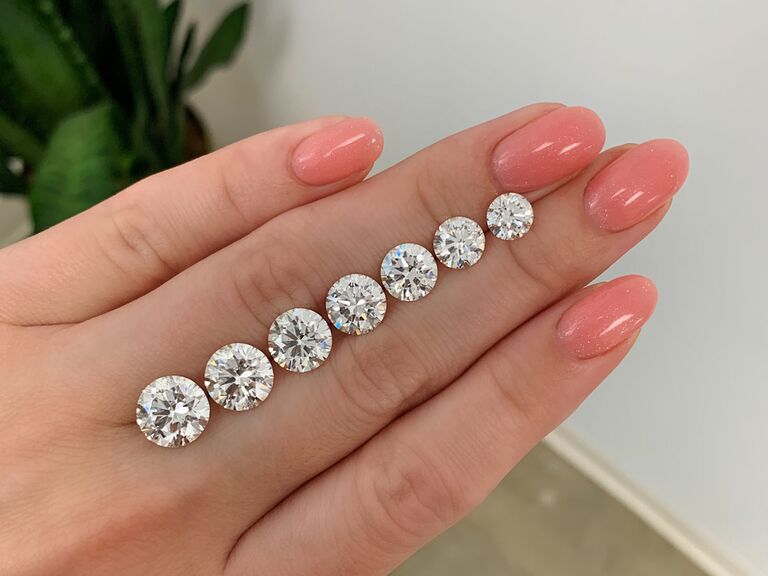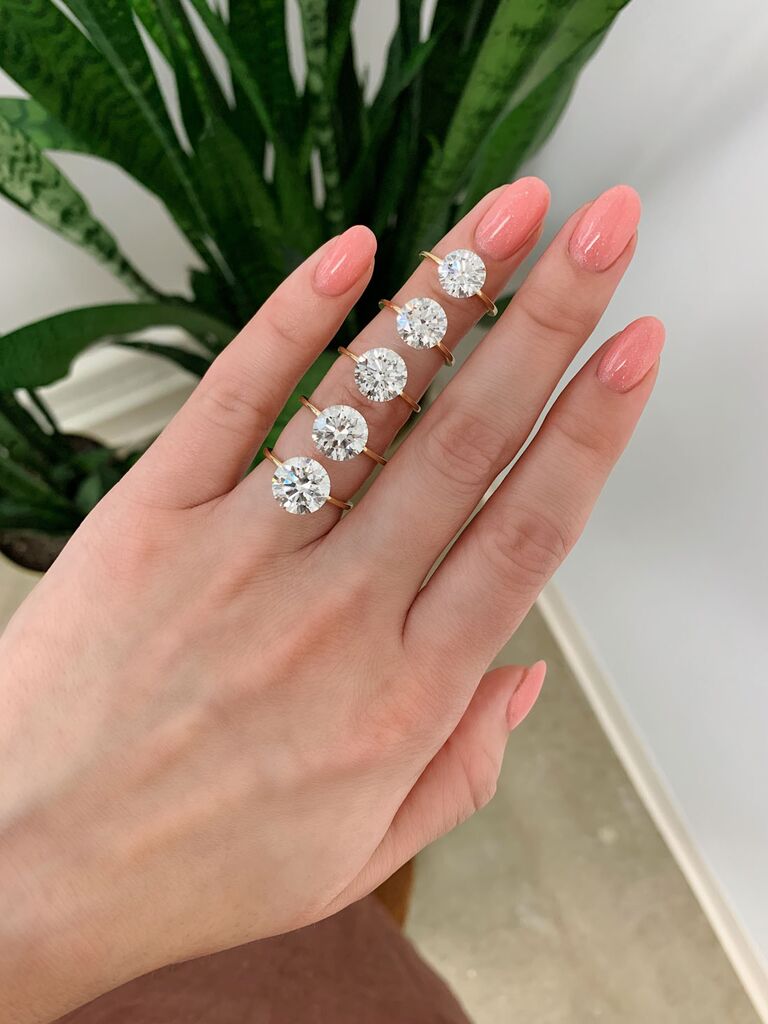When it comes to finding the perfect engagement ring, carat size is one of the most important characteristics. The weight of a ring is one of its most distinguishing features, and it can dramatically impact its cost and overall look. So, if you’re trying to narrow down the ideal ring size for your budget and style, it can be helpful to see different diamond carat sizes on a hand.
@media(max-width:768px){#ad-embedded-slot-1-container{min-height:270px}}
Since an engagement ring often comes with a higher price tag, it’s important to do your research ahead of time to ensure you’re making the right decision. To help, we’re taking the guesswork out of carat sizes. We’ve tapped jewelry experts to share everything you need to know about different diamond carat sizes, along with photos of diamond carat sizes on a finger to help make an educated choice.
What is Carat Size?
Whether you’re a diamond expert or a novice to the fine jewelry industry, it’s important to understand the “four C’s” of jewelry: carat, color, cut and clarity. These are the four most defining features of a diamond or a gemstone, and they’re used to price and grade a gem. One of the most defining features, though, is carat size. “A carat is a unit of weight,” says jeweler Kendra Pariseault. “It’s measured by placing the diamond on a scale.” One carat weighs about .20 grams—and as carat size increases, so does the rarity and price.
@media(max-width:768px){#ad-embedded-slot-17q4mthin-container{min-height:70px}}
Keep in mind that, visually, carat size is not the same for different gemstones and cuts. For example, a 1-carat diamond and a 1-carat sapphire are not going to look the same size, but on a scale, they’ll weigh the same. This is because different gemstones have different densities. A diamond will visually look larger than the sapphire, even though they weigh the same.
Similarly, a 1-carat oval diamond may look larger than a 1-carat square diamond because their proportions are different. A setting can also make a gemstone look larger than it is as well (which is why the halo style has been consistently popular). Since a variety of factors can affect the visual appearance of a diamond, carat size is not the only feature that affects the look of a ring—but it’s an important factor of the overall purchase.
@media(max-width:768px){#ad-embedded-slot-2-container{min-height:270px}}
Diamond Carat Sizes on a Real Hand
Seeing diamond carat sizes on a hand is the best way to get an idea of the weight you like. To help you visualize different carat sizes, the photo below depicts seven carat sizes on a hand.

From left to right, the different carat sizes shown are 4 carats, 3.5 carats, 3 carats, 2.5 carats, 2 carats, 1.5 carats and 1 carat.
A ring’s setting can also affect the look of the diamond. Below, five round diamonds are shown on a size six finger in an open setting (meaning there are no prongs securing them).
@media(max-width:768px){#ad-embedded-slot-4-container{min-height:70px}} 
From bottom to top, the different carat sizes shown are 4 carats, 3.5 carats, 3 carats, 2.5 carats and 2 carats.
How to Pick the Right Carat Size
When it comes to picking the right diamond carat size, budget is the most important consideration. If you’re shopping within strict price parameters, avoid going over—it’s better to buy in your price range than to start off your engagement in debt. To make the most of your purchase, consider buying a carat size slightly under your preferred weight. For example, if you want to buy a 3-carat diamond engagement ring, a 2.75-carat diamond will look almost the same at a lower cost. Work with your jeweler or an expert to source a diamond carat size that’s right for your style and within your preferred price range.
There are a number of additional ways to maximize your engagement ring budget too. The first is by opting for a lower color grade if you’re shopping for a white diamond. “The Gemological Institute of America (GIA) grades color on a scale from D-to-Z, measuring the lack of color within a diamond,” explains jeweler Lauren Addison. Colorless diamonds tend to be more expensive, but those close in range aren’t often noticeable to the untrained eye. If you’re looking to cut costs on an engagement ring, you can save by choosing a lower color grade without majorly affecting the look of the stone. “You will pay a premium for a diamond with a colorless grading (D-to-F), so consider opting for diamonds in the near colorless range (G-to-J)” suggests Addison. “This will save quite a bit of money while still achieving a white look.” Adds Ring Concierge founder Nicole Wegman: “Most of our clients opt for the largest carat weight their budget allows, so they’ll drop slightly lower in color and clarity without impacting the beauty of the diamond.”
@media(max-width:768px){#ad-embedded-slot-5-container{min-height:270px}}
The cut of a ring can also help it look larger than its actual carat size. “A diamond’s cut determines how well its facets interact with light and its ability to sparkle,” says Addison. Longer shapes like ovals, emeralds and marquise cuts can give the appearance of a larger carat size, and they’re universally flattering. “Elongated shapes are flattering on any hand, and they show their weight well,” says The Clear Cut founder Olivia Landau.
When it comes to buying your engagement ring, remember that you won’t regret making the most out of your purchase. “We have many clients come back to upgrade for a larger size, but never any that say they wish they’d gone smaller,” advises Wegman. “Don’t be nervous to opt for the largest carat your budget allows. As time passes you won’t regret going bigger.”
@media(max-width:768px){#ad-embedded-slot-6-container{min-height:70px}}